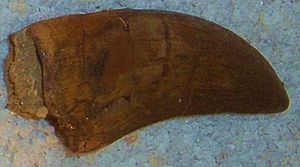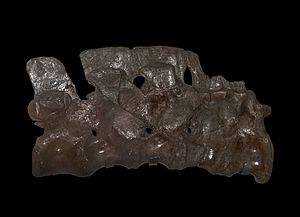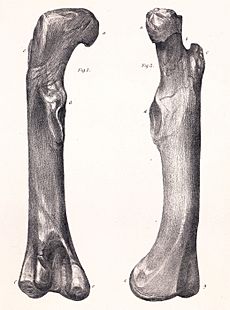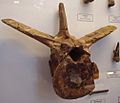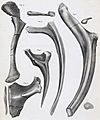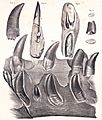Megalosaurus facts for kids
Quick facts for kids MegalosaurusTemporal range: Middle Jurassic
|
|
|---|---|
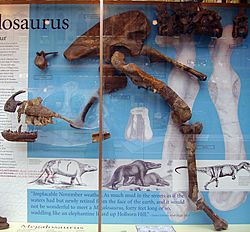 |
|
| Fossil specimens referred to M. bucklandii, Oxford University Museum of Natural History. | |
| Scientific classification | |
| Kingdom: | |
| Phylum: | |
| Class: | |
| Superorder: | |
| Order: | |
| Suborder: | |
| Family: | |
| Genus: |
Megalosaurus
Buckland, 1824
|
Megalosaurus was a large meat-eating theropod dinosaur of the Middle Jurassic of Europe. Imagine a creature bigger than a school bus, walking on two powerful legs, with a huge head full of sharp teeth. That's Megalosaurus! This fearsome dinosaur lived during the Jurassic period, a time long, long ago, between roughly 201 to 145 million years ago. That's millions of years before the very first humans walked the Earth!
The name Megalosaurus itself means "great lizard," a fitting name for such a massive beast. Scientists believe Megalosaurus was a theropod, a group of dinosaurs that walked on two legs and were mostly carnivores (meat-eaters). This means Megalosaurus spent its days hunting for other dinosaurs and maybe even some large prehistoric mammals or reptiles.
Contents
History
The story of Megalosaurus began not in a laboratory, but in a quarry in Oxfordshire, England, in 1676. A large bone fragment was discovered, but it wasn't recognized as a dinosaur bone at the time. People back then didn't know about dinosaurs. It was simply labeled as a "giant bone." This was the very first fossil of this dinosaur ever found.
It wasn't until 1824 that the first scientific description of Megalosaurus was published by William Buckland, a professor at Oxford University. Professor Buckland studied the bone fragments and realized they belonged to a creature unlike anything he had ever seen before. He gave this amazing creature its name: Megalosaurus bucklandii, in honor of his discovery. This was a huge step in our understanding of prehistoric life and marked the beginning of the science of paleontology – the study of ancient life!
Description
Unfortunately, early discoveries of Megalosaurus were based on very incomplete skeletons. Scientists had to make educated guesses about what the rest of the dinosaur looked like. Many early drawings of Megalosaurus were quite different from what we think it actually looked like today.
Over time, more fossils have been discovered. But even today, we only have partial skeletons of Megalosaurus. This is a common problem in paleontology. Often, we find only pieces of dinosaurs instead of complete skeletons. Scientists use these pieces, along with clues from related dinosaurs, to reconstruct what Megalosaurus may have looked like.
Megalosaurus had a long, powerful tail that it likely used for balance and to help it turn quickly while hunting. Its head was large and equipped with sharp, serrated teeth. The teeth were curved backwards like hooks, so once the Megalosaurus held its prey, it was nearly impossible for the animal to escape.
Its legs were strong and muscular, capable of supporting its huge body. Scientists believe it had three toes on each foot, ending in sharp claws that helped it grip the ground and possibly even help it hunt. Its arms were shorter than its legs and it most likely used them less often than its strong legs.
Size
Based on the evidence, scientists believe Megalosaurus was a very large bipedal (two-legged) dinosaur. Estimates of its size vary, but it likely measured between 7 and 9 meters (23 to 30 feet) long, and weighed between 1 and 2 tons.
What did it eat?
Megalosaurus was a fearsome predator. Its powerful jaws and sharp teeth suggest it was a carnivore, meaning it ate meat. It likely hunted other dinosaurs, possibly smaller herbivores (plant-eaters) that lived during the Jurassic period.
Life
Megalosaurus lived in a very different world than ours. During the Jurassic period, the climate was warmer and much more humid than today. Vast forests covered much of the land, and swamps and rivers provided habitats for a wide variety of plants and animals.
Many other dinosaurs lived alongside Megalosaurus, including massive herbivores like Stegosaurus and Brachiosaurus. Megalosaurus likely played an important role in its ecosystem as a top predator.
Megalosaurus Today:
Although Megalosaurus went extinct millions of years ago, its fossils continue to be studied by scientists, helping us piece together the puzzle of prehistoric life. Museums around the world display casts of Megalosaurus skeletons, allowing visitors to marvel at the size and majesty of this magnificent beast. Every new discovery helps scientists learn more about this early giant of the dinosaur world.
Images for kids
-
Lithography from William Buckland's "Notice on the Megalosaurus or great Fossil Lizard of Stonesfield", 1824. Caption reads "anterior extremity of the right lower jaw of the Megalosaurus from Stonesfield near Oxford".
-
1854 reconstruction in Crystal Palace Park guided by Richard Owen presents Megalosaurus as a quadruped; modern reconstructions make it bipedal, like most theropods
See also
 In Spanish: Megalosaurus bucklandii para niños
In Spanish: Megalosaurus bucklandii para niños




